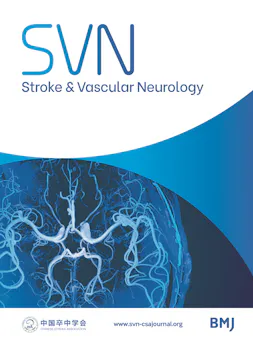Association between stroke subtypes and outcomes of endovascular therapy: a post-hoc analysis of the ANGEL-ASPECT Trial
IF 4.9
1区 医学
Q1 CLINICAL NEUROLOGY
引用次数: 0
Abstract
Objectives Our study aims to examine the value of endovascular therapy (EVT) and its comparison to medical management (MM) in ischaemic stroke patients accompanied by large artery atherosclerosis (LAA) and non-LAA Methods modified Rankin scale score (mRS) was evaluated at 90 days post the stroke attack and was considered as the primary outcome. Other outcomes measured in this study included score changes of 0–2 and 0–3 on the mRS. The occurrence of symptomatic intracranial haemorrhage at 24 hours after EVT was also measured as a safety endpoint. Logistic regression analysis was used to determine the associations. Results In the LAA group, no significant difference in mRS at 90-day (median IQR 3 (2–5) vs 4 (3–4), 95% CI 0.53 to 2.00, p=0.924), mRS 0–2 and mRS 0–3 was observed between EVT and MM groups. However, in the non-LAA group, patients who underwent EVT had lower 90-day mRS scores (4 (2–5) vs 4 (3–5), generalised OR 1.47, 95% CI 1.14 to 1.88, p<0.001). No interaction effect on the primary outcomes between treatment options and aetiology. More intracranial haemorrhage events within 48 hours were identified in the EVT group for both LAA and non-LAA cohorts (LAA: 40.98% vs 9.62%, relative risk (RR) 4.26, 95% CI 1.76 to 10.34, p<0.001; non-LAA, 52.07% vs 19.65%, RR 2.65, 95% CI 1.90 to 3.70, respectively). Conclusions For large infarcts, EVT may be more effective than MM for patients with non-LAA aetiology, but not for those with LAA stroke. As no interaction effect was found, the benefit of EVT compared with MM did not vary by stroke subtypes. Data are available on reasonable request.中风亚型与血管内治疗效果之间的关系:ANGEL-ASPECT 试验的事后分析
目的 我们的研究旨在探讨血管内治疗(EVT)的价值,以及它与药物治疗(MM)在伴有大动脉粥样硬化(LAA)和非大动脉粥样硬化的缺血性中风患者中的比较方法。本研究测量的其他结果包括 mRS 评分 0-2 分和 0-3 分的变化。EVT术后24小时内出现无症状颅内出血的情况也作为安全终点进行测量。采用逻辑回归分析确定相关性。结果 在LAA组中,EVT组和MM组在90天时的mRS(中位数IQR 3 (2-5) vs 4 (3-4),95% CI 0.53 to 2.00,p=0.924)、mRS 0-2和mRS 0-3方面无明显差异。然而,在非LAA组中,接受EVT的患者90天mRS评分较低(4 (2-5) vs 4 (3-5),广义OR 1.47,95% CI 1.14 to 1.88,p<0.001)。治疗方案与病因对主要结果无交互影响。在LAA和非LAA队列中,EVT组在48小时内发现了更多的颅内出血事件(LAA:40.98% vs 9.62%,相对风险(RR)4.26,95% CI 1.76至10.34,p<0.001;非LAA:52.07% vs 19.65%,RR 2.65,95% CI 1.90至3.70)。结论 对于大面积脑梗死,对于非LAA病因的患者,EVT可能比MM更有效,但对于LAA脑卒中患者则不然。由于未发现交互效应,EVT 与 MM 相比的获益并不因卒中亚型而异。如有合理要求,可提供相关数据。
本文章由计算机程序翻译,如有差异,请以英文原文为准。
求助全文
约1分钟内获得全文
求助全文
来源期刊

Stroke and Vascular Neurology
Medicine-Cardiology and Cardiovascular Medicine
CiteScore
11.20
自引率
1.70%
发文量
63
审稿时长
15 weeks
期刊介绍:
Stroke and Vascular Neurology (SVN) is the official journal of the Chinese Stroke Association. Supported by a team of renowned Editors, and fully Open Access, the journal encourages debate on controversial techniques, issues on health policy and social medicine.
 求助内容:
求助内容: 应助结果提醒方式:
应助结果提醒方式:


